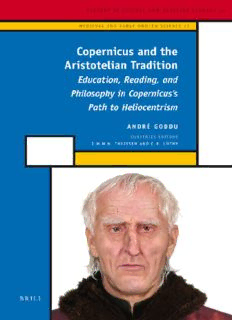
Copernicus and the Aristotelian Tradition: Education, Reading, and Philosophy in Copernicus's Path to Heliocentrism PDF
Preview Copernicus and the Aristotelian Tradition: Education, Reading, and Philosophy in Copernicus's Path to Heliocentrism
Copernicus and the Aristotelian Tradition History of Science and Medicine Library VOLUME 15 Medieval and Early Modern Science Editors J.M.M.H. Th ijssen, Radboud University Nijmegen C.H. Lüthy, Radboud University Nijmegen Editorial Consultants Joël Biard, University of Tours Simo Knuuttila, University of Helsinki John E. Murdoch, Harvard University Jürgen Renn, Max-Planck-Institute for the History of Science Th eo Verbeek, University of Utrecht VOLUME 12 Copernicus and the Aristotelian Tradition Education, Reading, and Philosophy in Copernicus’s Path to Heliocentrism By André Goddu LEIDEN • BOSTON 2010 On the cover: Reconstruction of Copernicus’s face. Reproduced with the kind per- mission of Prof. Dr. Jerzy Gąssowski, Director of the Institute of Anthropology and Archaeology of the Pultusk Academy of Humanities, Poland, who was responsible for the Copernicus program, the excavation of his grave, and the discovery of his remains. Th is book is printed on acid-free paper. Library of Congress Cataloging-in-Publication Data Goddu, André, 1945– Copernicus and the Aristotelian tradition : education, reading, and philosophy in Copernicus’s path to heliocentrism / by André Goddu. p. cm. — (History of science and medicine library, ISSN 1872-0684 ; v. 15) Includes bibliographical references and index. ISBN 978-90-04-18107-6 (hardback : alk. paper) 1. Copernicus, Nicolaus, 1473–1543—Knowledge and learning. 2. Copernicus, Nicolaus, 1473–1543—Sources. 3. Astronomy—History—16th century. 4. Cosmology—History—16th century. 5. Science—History—16th century. 6. Philosophy, Medieval. I. Title. QB36.C8G635 2010 520.92—dc22 2009047722 ISSN 1872-0684 ISBN 978 90 04 18107 6 Copyright 2010 by Koninklijke Brill NV, Leiden, Th e Netherlands. Koninklijke Brill NV incorporates the imprints Brill, Hotei Publishing, IDC Publishers, Martinus Nijhoff Publishers and VSP. All rights reserved. No part of this publication may be reproduced, translated, stored in a retrieval system, or transmitted in any form or by any means, electronic, mechanical, photocopying, recording or otherwise, without prior written permission from the publisher. Authorization to photocopy items for internal or personal use is granted by Koninklijke Brill NV provided that the appropriate fees are paid directly to Th e Copyright Clearance Center, 222 Rosewood Drive, Suite 910, Danvers, MA 01923, USA. Fees are subject to change. printed in the netherlands To Kayo and Seisei CONTENTS List of Illustrations ............................................................................. xi Preface .................................................................................................. xiii Acknowledgements ........................................................................... xix Introduction ......................................................................................... xxi PART I COPERNICUS’S EDUCATION IN POLAND Chapter One Poland, Toruń, and Cracow in the Fift eenth Century ............................................................................................ 5 1. Early Education ......................................................................... 5 2. Cracow University .................................................................... 13 3. Curriculum and Texts, 1475–1500 ......................................... 25 Chapter Two Masters and Students in the 1490s ...................... 35 Chapter Th ree Th e Teaching of Logic ......................................... 51 1. Aristotelian Logic—Introductory Orientation ..................... 52 2. Th e Teaching of Logic at Cracow .......................................... 72 Chapter Four Natural Philosophy ................................................ 89 1. General Orientation .................................................................. 89 2. Markowski’s Most Important and Relevant Conclusions ................................................................................ 97 3. Th e Quaestiones cracovienses on the Physics of Aristotle ... 99 4. Aristotle’s De caelo, De generatione, Meteorologica, and Metaphysics ................................................................................. 114 5. Johannes Versoris ..................................................................... 122 6. Albert of Saxony and John of Glogovia ................................ 128 Chapter Five Humanism and Astronomy ................................... 137 1. Introduction ............................................................................... 137 2. Th e Curriculum at Cracow ...................................................... 145 3. Th e Criticisms of Ptolemaic Astronomy ............................... 154 viii contents 4. Copernicus’s Teachers at Cracow .......................................... 159 5. Albert of Brudzewo’s Commentariolum ................................ 162 PART II COPERNICUS’S EDUCATION IN ITALY, 1496–1503, AND RETURN TO POLAND Chapter Six Copernicus in Italy .................................................... 171 1. Introduction ............................................................................... 171 2. Copernicus’s Education in Canon and Civil Law ............... 173 3. Copernicus and Novara ........................................................... 187 4. Copernicus’s Study of Greek ................................................... 193 5. Copernicus in Rome ................................................................. 197 6. Copernicus’s Study of Medicine at Padua ............................ 198 7. Copernicus’s Degree from Ferrara ......................................... 203 Chapter Seven Copernicus’s Reading and Progress towards his First Heliocentric Th eory ........................................................ 207 1. Introduction ............................................................................... 207 2. Regiomontanus’s Epitome ........................................................ 215 3. Bessarion’s In calumniatorem Platonis .................................. 220 4. Ficino’s Translation of Plato’s Works ................................... 225 5. Plutarch, Pseudo-Plutarch (Aëtius) and Giorgio Valla ...... 229 6. Pliny’s Natural History and other Ancient Authorities ..... 237 7. Achillini ...................................................................................... 238 8. Commentariolus ......................................................................... 243 PART III COPERNICUS AS PHILOSOPHER Chapter Eight Copernicus as Logician ........................................ 275 1. Introduction ............................................................................... 275 2. Th e Sources of Dialectical Topics, 1490–1550 ..................... 279 3. Mereology—Logic and Ontology ........................................... 285 4. Logic in the Commentariolus .................................................. 291 5. Th e Use of Topics in the Preface of De revolutionibus ...... 292 6. Th e Rhetorical Framework of Book I .................................... 300 7. Th e Use of Topics in Book I ................................................... 304 contents ix 8. Hypotheses in Copernicus’s Method .................................. 314 9. Th e Logical Issues in the Relation between Mathematics and Natural Philosophy ......................................................... 317 10. Th e Logical Issues in his Discovery of the Heliocentric Th eory ....................................................................................... 321 11. Concluding Remarks on Copernicus’s Relation to the Aristotelian Logical Tradition .............................................. 323 Chapter Nine Copernicus as Natural Philosopher .................... 325 1. Introduction ............................................................................. 325 2. Copernicus’s Critique of Geocentrism ................................ 326 3. Th e Motions of Celestial Bodies ........................................... 332 4. Impetus and the Motions of Elemental Bodies ................. 336 5. Infi nity and the Finiteness of the Cosmos ......................... 355 6. Summary .................................................................................. 358 Chapter Ten Copernicus as Mathematical Cosmologist .......... 361 1. Introduction ............................................................................. 361 2. Hypotheses ............................................................................... 362 3. Spheres and the Nature of Celestial Matter ....................... 370 4. Equants ..................................................................................... 381 5. Summary .................................................................................. 384 Conclusion and Epilogue .................................................................. 387 1. Summary .................................................................................. 387 2. Copernicus’s Interpretation of Aristotle ............................. 389 3. Epilog: Reception of Copernicus’s Interpretation ............. 403 Appendices ........................................................................................... 439 Bibliography ......................................................................................... 495 Indices Index of Names .............................................................................. 525 Index of Places ................................................................................ 536 Index of Subjects ............................................................................ 538
Description: